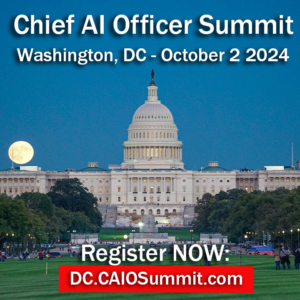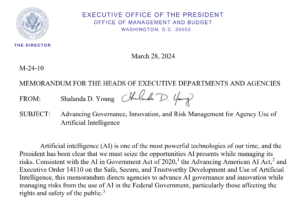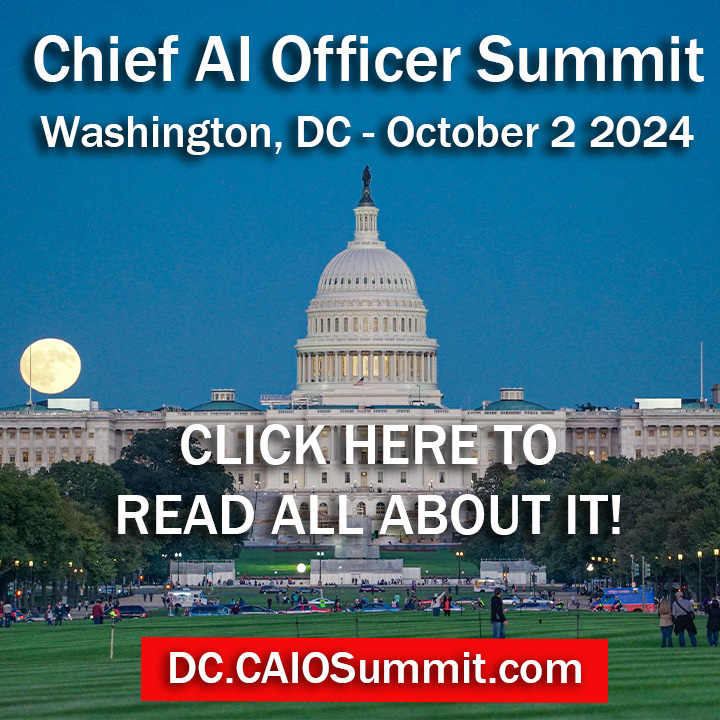On Thursday 3/28/24, to further the Biden-Harris new Executive Order on AI, U.S. Office of Management and Budget (OMB) Director Shalanda Young sent a memorandum to all federal agencies, directing them to name Chief AI Officers and to advance AI governance and innovation while managing AI risks in US government.
Today we’ll take a look at the responsibilities of the Chief AI Officer role required at federal agencies.
Thanks to the Biden-Harris administration and the Office of Management and Budget for use of this material. We excerpted pages 4-8 from the memorandum for this post. You can access the full memo here.
3. STRENGTHENING ARTIFICIAL INTELLIGENCE GOVERNANCE
“To improve accountability for AI issues, agencies must designate a Chief AI Officer (CAIO), consistent with Section 10.1(b) of Executive Order 14110. CAIOs bear primary responsibility on behalf of the head of their agency for implementing this memorandum and coordinating implementation with other agencies.
This section defines CAIOs’ roles, responsibilities, seniority, position, and reporting structure.
a. Actions
- Designating Chief AI Officers. Within 60 days of the issuance of this memorandum, the head of each agency must designate a CAIO. To ensure the CAIO can fulfill the responsibilities laid out in this memorandum, agencies that have already designated a CAIO must evaluate whether they need to provide that individual with additional authority or appoint a new CAIO. Agencies must dentify these officers to OMB through OMB’s Integrated Data Collection process or an OMB-designated successor process. When the designated individual changes or the position is vacant, agencies must notify OMB within 30 days.
- Convening Agency AI Governance Bodies. Within 60 days of the issuance of this memorandum, each CFO Act agency must convene its relevant senior officials to coordinate and govern issues tied to the use of AI within the Federal Government, consistent with Section 10.1(b) of Executive Order 14110 and the detailed guidance in Section 3(c) of this memorandum.
b. Roles, Responsibilities, Seniority, Position, and Reporting Structure of Chief Artificial Intelligence Officers: Consistent with Section 10.1(b)(ii) of Executive Order 14110, this memorandum defines CAIOs’ roles, responsibilities, seniority, position, and reporting structures as follows:
- i. Roles. CAIOs must have the necessary skills, knowledge, training, and expertise to perform the responsibilities described in this section. At CFO Act agencies, a primary role of the CAIO must be coordination, innovation, and risk management for their agency’s use of AI specifically, as opposed to data or IT issues in general. Agencies may choose to designate an existing official, such as a Chief Information Officer (CIO), Chief Data Officer (CDO), Chief Technology Officer, or similar official with relevant or complementary authorities and responsibilities, provided they have significant expertise in AI and meet the other requirements in this section.
- ii. Responsibilities. Executive Order 14110 tasks CAIOs with primary responsibility in their agencies, in coordination with other responsible officials, for coordinating their agency’s use of AI, promoting AI innovation, managing risks from the use of AI, and carrying out the agency responsibilities defined in Section 8(c) of Executive Order 1396012 and Section 4(b) of Executive Order 14091.
- iii. Seniority. For CFO Act agencies, the CAIO must be a position at the Senior Executive Service, Scientific and Professional, or Senior Leader level, or equivalent. In other agencies, the CAIO must be at least a GS-15 or equivalent.
- iv. Position and Reporting Structure. CAIOs must have the necessary authority to perform the responsibilities in this section and must be positioned highly enough to engage regularly with other agency leadership, to include the Deputy Secretary or equivalent. Further, CAIOs must coordinate with other responsible officials at their agency to ensure that the agency’s use of AI complies with and is appropriate in light of applicable law and governmentwide guidance.
In addition, CAIOs, in coordination with other responsible officials and appropriate stakeholders, are responsible for:
Coordinating Agency Use of AI
A. serving as the senior advisor for AI to the head of the agency and other senior agency leadership and within their agency’s senior decision-making forums;
B. instituting the requisite governance and oversight processes to achieve compliance with this memorandum and enable responsible use of AI in the agency, in coordination with relevant agency officials;
C. maintaining awareness of agency AI activities, including through the creation and maintenance of the annual AI use case inventory;
D. developing a plan for compliance with this memorandum, as detailed in Section 3(a)(iii) of this memorandum, and an agency AI strategy, as detailed in Section 4(a) of this memorandum;
E. working with and advising the agency CFO on the resourcing requirements necessary to implement this memorandum and providing recommendations on priority investment areas to build upon existing enterprise capacity;
F. advising the Chief Human Capital Officer (CHCO) and where applicable, the Chief Learning Officer, on improving workforce capacity and securing and maintaining the skillsets necessary for using AI to further the agency’s mission and adequately manage its risks;
G. sharing relevant information with agency officials involved in the agency’s major AI policymaking initiatives;
H. supporting agency involvement with appropriate interagency coordination bodies related to their agency’s AI activities, including representing the agency on the council described in Section 10.1(a) of Executive Order 14110;
I. supporting and coordinating their agency’s involvement in AI standards-setting bodies, as appropriate, and encouraging agency adoption of voluntary consensus standards for AI, as appropriate and consistent with OMB Circular No. A-119, if applicable;
J. promoting equity and inclusion within the agency’s AI governance structures and incorporating diverse perspectives into the decision-making process;
Promoting AI Innovation
K. working with their agency to identify and prioritize appropriate uses of AI that will advance both their agency’s mission and equitable outcomes;
L. identifying and removing barriers to the responsible use of AI in the agency, including through the advancement of AI-enabling enterprise infrastructure, data access and governance, workforce development measures, policy, and other resources for AI innovation;
M. working with their agency’s CIO, CDO, and other relevant officials to ensure that custom-developed AI code and the data used to develop and test AI are appropriately inventoried, shared, and released in agency code and data repositories in accordance with Section 4(d) of this memorandum;
N. advocating within their agency and to the public on the opportunities and benefits of AI to the agency’s mission;
Managing Risks from the Use of AI
O. managing an agency program that supports the enterprise in identifying and managing risks from the use of AI, especially for safety-impacting and rightsimpacting AI;
P. working with relevant senior agency officials to establish or update processes to measure, monitor, and evaluate the ongoing performance and effectiveness of the agency’s AI applications and whether the AI is advancing the agency’s mission and meeting performance objectives;
Q. overseeing agency compliance with requirements to manage risks from the use of AI, including those established in this memorandum and in relevant law and policy;
R. conducting risk assessments, as necessary, of the agency’s AI applications to ensure compliance with this memorandum;
S. working with relevant agency officials to develop supplementary AI risk management guidance particular to the agency’s mission, including working in coordination with officials responsible for privacy and civil rights and civil liberties on identifying safety-impacting and rights-impacting AI within the agency;
T. waiving individual applications of AI from elements of Section 5 of this memorandum through the processes detailed in that section; and
U. in partnership with relevant agency officials (e.g., authorizing, procurement, legal, data governance, human capital, and oversight officials), establishing controls to ensure that their agency does not use AI that is not in compliance with this memorandum, including by assisting these relevant agency officials in evaluating Authorizations to Operate based on risks from the use of AI.”
“Federal agencies have a distinct responsibility to identify and manage AI risks because of the role they play in our society, and the public must have confidence that the agencies will protect their rights and safety,” OMB Director Shalanda Young said in the memo.
Review our recent posts on this topic:
- 4/4/24: OMB memorandum on “Advancing Governance, Innovation, and Risk Management for gency Use of Artificial Intelligence” (3/28/24). OMB announced that the Biden-Harris White House has launched a “national talent search” for Chief AI Officers and AI professionals in the hope of hiring at least 100 by this summer.
- 4/2/24: Executive Order: “White House directs federal agencies to name Chief AI Officers” (3/28/24). The Biden-Harris White House announced a sweeping new policy to promote the safe use of AI by the federal government. The policy includes three binding requirements that mandates all federal agencies: to provide concrete safeguards against AI harm; to provide transparency for AI use cases; and to appoint a Chief AI Officer.
If you are interested in a Chief AI Officer or CDAO role, be sure to reach out to us!
Want to learn more, and meet some of those new CAIOs in person?
Join our 11th CDAO Summit & 3rd Chief AI Officer Summit Tue-Wed October 1-2, 2024.
Delegates, speakers, and sponsors can participate in one or both events.
 |
 |
- Angela Cough: Senior Advisor, Digital Talent, Chief Digital and Artificial Intelligence Office, U.S. Department of Defense
- Anthony Scriffignano: Distinguished Fellow, Alfred Lee Loomis Innovation Council, The Stimson Center
- Austin Gerig: Chief Data Officer, U.S. Securities and Exchange Commission
- Brian Peretti: Deputy Chief Artificial Intelligence Officer and Director Domestic and International Cyber Policy, U.S. Department of the Treasury
- Daniel Bernard: Chief Product and Technology Officer, Hearst Magazines
- David Chivers: Former President, Publisher, CDO at WSJ, Dow Jones, USA Today, Gannett, Des Moines Register, Meredith Corporation
- David Mathison: CEO, CAIO Summit/CDAO Summit; CDO Club
- Diane Staheli: Assistant Director, AI Applications, Office of Science and Tech Policy, The White House
- Dr. Delester Brown Jr: Chief Data Officer, National Guard Bureau
- Dr. Mike Horton: Deputy Chief Data Officer, US Department of Transportation (DOT)
- Florin Rotar: Chief AI Officer, Avanade
- Iwao Fusillo: Global Head of Data & Analytics – eCommerce, PepsiCo
- Marie Falkowski: Deputy IC Chief Data Officer & Deputy ADNI for Data & Partnerships, Office of the Director of National Intelligence
- Mark Brady: Deputy Chief Data Officer for TRMC, KBR, Inc.
- Marc Lavallee: Director of Technology Product and AI Strategy/Journalism, Knight Foundation
- Mark McCreary: Partner, Chief Artificial Intelligence & Information Security Officer, Fox Rothschild
- Paul Evangelista: Chief Data Officer, U.S. Military Academy at West Point
- Sonal Shah: CEO, The Texas Tribune
- Spence Green: CEO, Lilt
- Tanya Dua: Technology Editor, LinkedIn
- Thomas Sasala: Deputy Director, Office of Enterprise Management, U.S. Army
- Vinay Vijay Singh: Chief AI Officer, U.S. Department of Housing and Urban Development
- Vivian Schiller: VP and Executive Director, The Aspen Institute
- Yudong Cao: Chief Technology Officer, Zapata AI
- More to come, stay tuned!
THANK YOU to our all-star partners:
☆ LILT: https://lilt.com
☆ Zapata AI: https://zapata.ai
☆ Domino Data Lab: https://domino.ai
☆ govCDOiq: https://govcdoiq.org
☆ CDO Club: https://CDOClub.com












